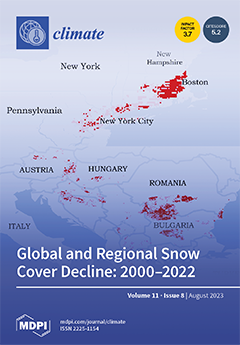This study analyzed long-term extreme precipitation indices using 4 × 4 km gridded data obtained from the National Meteorological Agency of Ethiopia between 1981 and 2018. The study examined trends in extreme precipitation over three districts (Lay Gayint, Tach Gayint, and Simada) in
[...] Read more.
This study analyzed long-term extreme precipitation indices using 4 × 4 km gridded data obtained from the National Meteorological Agency of Ethiopia between 1981 and 2018. The study examined trends in extreme precipitation over three districts (Lay Gayint, Tach Gayint, and Simada) in the northwestern highlands of Ethiopia. Innovative Trend Analysis (ITA) and Mann–Kendall (MK) trend tests were used to study extreme precipitation trends. Based on the ITA result, the calculated values of nine indices (90% of the analyzed indices) showed significant increasing trends (
p < 0.01) in Lay Gayint. In Tach Gayint, 70% (seven indices) showed significantly increasing trends at
p < 0.01. On the other hand, 60% of the extreme indices showed significant downward trends (
p < 0.01) in Simada. The MK test revealed that 30% of the extreme indices had significantly increasing trends (
p < 0.01) in Lay Gayint. In Tach Gayint, 30% of the extreme indices showed significant increasing trends at
p < 0.05, while 10% of the extreme indices exhibited significant increasing trends at
p < 0.01. In Simada, 20% of the extreme indices showed significant increasing trends at
p < 0.05. Overall, the results showed that the ITA method can identify a variety of significant trends that the MK test misses.
Full article
 to open them.
to open them.




